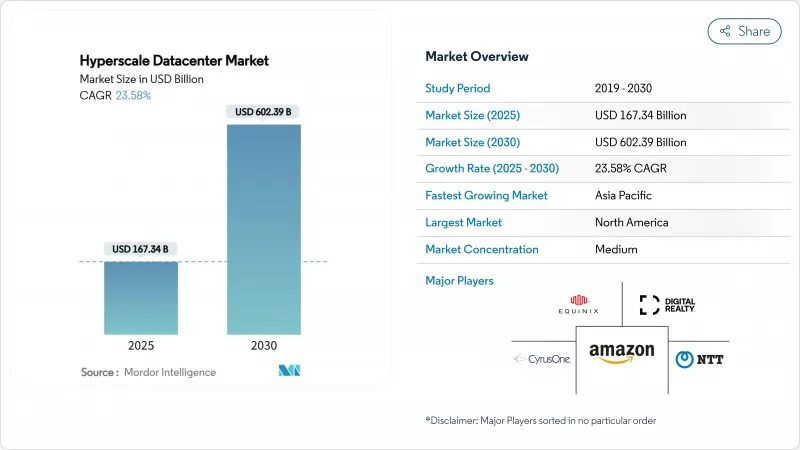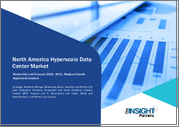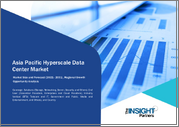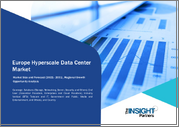
|
시장보고서
상품코드
1851105
하이퍼스케일 데이터센터 시장 : 시장 점유율 분석, 산업 동향, 통계, 성장 예측(2025-2030년)Hyperscale Datacenter - Market Share Analysis, Industry Trends & Statistics, Growth Forecasts (2025 - 2030) |
||||||
하이퍼스케일 데이터센터 시장의 2025년 시장 규모는 1,673억 4,000만 달러로 추정되고, 2030년에는 6,023억 9,000만 달러에 이를 것으로 예측되며, CAGR 23.58%로 견조하게 추이할 전망입니다.

규모의 경제성, AI를 중심으로 한 하드웨어 수요, 소블린 클라우드 규제가 설비 설계를 재구축하고 있으며, GPU 랙의 전력 밀도는 일상적으로 50kW를 넘고 있습니다. 유럽과 아시아태평양에서는 주요 핀텍 허브에서 실시간 결제의 의무화와 함께 새로운 용량의 연간 3GW를 넘는 건설 파이프라인이 유지되고 있습니다. 오퍼레이터는 공냉에서 칩으로 직접 냉각하는 액냉에 축발을 옮기고 있으며, 네덜란드와 싱가포르에서는 규제에 의한 열세가 도입되어 탄소를 고려한 입지 선정에 대한 관심이 높아지고 있습니다. 실리콘 부족과 유틸리티의 리드타임이 장기화되고 있는 가운데, 전략적인 랜드뱅킹과 다년간의 GPU 공급 계약이 결정적인 경쟁력이 되고 있습니다.
세계의 하이퍼스케일 데이터센터 시장 동향 및 인사이트
미국과 중국에서 50kW 이상의 랙이 필요한 GPU 중심의 AI/ML 워크로드가 폭발적으로 증가
AI 트레이닝 클러스터는 시설 레이아웃을 재구성하고 있으며 Google은 이미 ±400 VDC의 전력을 소비하는 1MW 랙을 도입했습니다. 멤피스에 있는 xAI의 20만 GPU 캠퍼스는 혁신의 규모를 돋보이게 하고 있으며, 데이터센터 팀은 배전, 네트워크 패브릭, 액냉 루프를 레거시 서버보다 160%나 에너지 소비량이 많은 랙을 중심으로 재설계할 필요가 있습니다. 미국과 중국은 지원 AI 자금 조달 생태계와 민첩한 허가 프레임워크 덕분에 개발을 지배하고 있습니다.
유럽에서 하이퍼스케일 클라우드 공급자의 주권 클라우드 전개
유럽의 데이터 거주법에서는 'EU 한정'의 운영 관리가 의무화되어 있기 때문에 AWS는 2040년까지 독일의 소블린 클라우드에 78억 유로(85억 달러)를 투자할 전망입니다. 독일 텔레콤의 '8ra' 구상은 10,000대의 엣지 노드를 목표로 하며 미국의 클라우드 스택에 대한 의존도를 낮추려는 현지 기존 기업의 의향을 보여줍니다. 소블린 모델은 컴플라이언스에 그치지 않고 자국의 AI 연구 개발을 촉진하고 지역의 하드웨어 공급망을 활성화합니다. 프랑스에서는 Orange와 Capgemini의 Bleu 플랫폼을 통해 이미 그 기세를 볼 수 있으며, 중동이나 APAC의 일부에서도 같은 요건이 요구되는 것을 예감시킵니다.
미국 서부와 스페인에서 증발식 냉방의 물 사용 제한
캘리포니아의 규제 당국은 현재 물 사용량을 줄이는 냉매 기반 시스템을 의무화하고 있으며 설비 투자를 최대 20%까지 증가시키고 있습니다. 애리조나 주에서는 1MW 시설이 연간 675만 갤런을 소모한다고 보고되었으며, 데이터센터는 농업 및 주택과 함께 감시 하에 있습니다. 스페인의 가뭄도 유사한 규제의 방아쇠가 되었고, 개발자는 해수 담수화 파이프라인이 있는 연안부의 구획, 폐쇄형 루프 액냉을 사용한 내륙부의 캠퍼스로 방향타를 자르고 있습니다.
부문 분석
아마존의 1,500억 달러의 다년 로드맵과 같은 자본 집약적인 프로그램을 타고, 셀프 빌드 사업자가 2024년 하이퍼스케일 데이터센터 시장 점유율의 70.2%를 차지했습니다. 설계를 제어하면 AI 클러스터에 맞게 조정된 맞춤형 파워트레인과 자체 네트워크 패브릭이 가능합니다. 그러나 하이퍼스케일 코로케이션의 CAGR은 25.6%가 될 것으로 예측되고 있으며, 새로운 지역에서는 시장 투입 속도가 자산 관리를 능가하기 때문에 소유권 격차는 축소됩니다.
코로케이션 프로바이더는 사전에 토지와 전력을 확보하고, 12개월의 리드 타임으로 모듈러 스위트를 제공함으로써 클라우드 진출 기업의 가동률 향상을 가속화하고 있습니다. Vantage의 92억 달러의 증자는 이러한 사업 확대를 뒷받침하고 있으며, 장기적인 하이퍼스케일 계약에 연관된 경상 수익에 대한 프라이빗 에퀴티의 의욕을 나타내고 있습니다. 더 많은 소블린 클라우드 계약이 지역 파트너를 규정하기 때문에 코로케이션은 신흥 시장에서 전략적 관련성을 늘리고 있습니다.
이 부문은 2024년 IT 인프라 구매를 통한 하이퍼스케일 데이터센터 시장 규모의 48%를 차지했으며, GPU, DDR5 메모리 및 NVMe 스토리지가 지갑 공유를 견인합니다. 30MW 리튬 이온 농장과 같은 전기 백업 시스템은 현재 표준 부품표에 포함되어 있습니다. 소프트웨어 및 서비스는 CAGR 27.1%로 상승하고 있으며, 전력 및 랙 밀도 향상을 초래하는 AI 주도 자원 오케스트레이션에 대한 수요를 반영하고 있습니다.
멀티테넌트의 AI 워크로드가 리스크 프로파일을 높이는 동안 제로 트러스트 프레임워크와 통합된 보안 스택이 기준선 모니터링 툴을 능가합니다. 예측 기간 동안 워크로드의 자동 배치는 기존 사용을 극대화하여 8-10GW의 신규 구축을 연기할 것으로 예측됩니다.
지역별 분석
북미는 2024년 하이퍼스케일 데이터센터 시장의 43.3%를 차지했으며, 지역별로는 최대 매출을 기록했습니다. 버지니아의 '데이터센터 어레이'만으로 작년에는 2GW의 신규 변전소 수요를 클리어했지만, 송전망의 혼잡은 현재 아마존이 복수의 AI 대응 캠퍼스에 300억 달러를 투입하고 있는 오하이오주, 펜실베니아주, 노스캐롤라이나주에 수요를 유도하고 있습니다. 전력회사의 상호접속 스케줄은 최장 7년이 걸리기 때문에 지역 간의 다양성 전략, 탄소 익스포저를 헤지하는 재생에너지 전력 구입 계약이 촉구되고 있습니다.
아시아태평양은 29.1%의 연평균 복합 성장률(CAGR)이 예측되는 명백한 성장 엔진입니다. 일본은 AWS의 2조 2,600억 엔(151억 달러) 확장을 배경으로 한 투자의 중심이며, Oracle과 NTT는 국내 AI와 게임 워크로드에 대응하기 위해 용량을 추가하고 있습니다. 인도에서는 세금 혜택과 디지털 공공재의 틀로 뭄바이에서 하이데라바드까지 전국적인 하이퍼스케일 회랑이 추진되고 있습니다. 싱가포르는 일시적인 모라토리엄에도 불구하고 지속가능성 스코어카드를 기반으로 승인을 재개하여 ASEAN의 핀테크 흐름에 대응하는 새로운 Tier IV 파이프라인을 확보했습니다.
유럽은 소블린 만데이트와 북유럽의 신재생 에너지에 힘입어 안정된 자금 유입을 즐길 수 있습니다. 브룩필드의 100억 달러를 투자한 스웨덴 캠퍼스와 구글의 6억 유로(6억 5,000만 달러)를 투자한 노르웨이 시설은 냉량한 기후 및 그린 전력망이 PUE를 1.15 이하로 억제한 방법을 보여줍니다. 네덜란드의 열세와 더블린 주변의 전력 상한은 공급 규율을 만들어, 사업자를 대륙의 2급 도시로 유도하고 있습니다. 향후 성장은 환경 제약과 '디지털 10년' 클라우드 구축 목표의 조화에 달려 있습니다.
기타 혜택 :
- 엑셀 형식 시장 예측(ME) 시트
- 3개월의 애널리스트 서포트
목차
제1장 서론
- 조사의 전제조건 및 시장 정의
- 조사 범위
제2장 조사 방법
제3장 주요 요약
제4장 시장 상황
- 시장 개요
- 시장 성장 촉진요인
- 미국과 중국에서 50kW 이상의 랙을 필요로 하는 GPU 중심의 AI/ML 워크로드 폭발이 시장 견인
- 유럽에서의 하이퍼스케일 클라우드 프로바이더의 'Sovereign Cloud' 전개가 시장 견인
- FinTech 실시간 결제의 의무화에 의해 싱가포르와 인도의 Tier IV 수요 가속 및 시장 견인
- 북유럽과 오세아니아에서 지역 허브 요건을 만들어내는 5G 엣지 코어의 통합이 시장 견인
- 시장 성장 억제요인
- 미국 서부 및 스페인에서 증발 냉각의 물 사용량 규제
- 랙 레벨의 고밀도화를 막는 GPU 공급망의 병목
- 네덜란드, 싱가포르, 독일에서 열세 및 탄소세의 상승이 시장 방해
- 밸류체인 분석
- 규제 및 컴플라이언스의 전망
- 기술적 전망(액냉, Direct-to-Chip, 모듈 빌드)
- 시장의 거시 경제 동향의 평가
- Porter's Five Forces 분석
- 공급기업의 협상력
- 구매자의 협상력
- 신규 참가업체의 위협
- 대체품의 위협
- 경쟁 기업 간 경쟁 관계
제5장 시장 규모 및 성장 예측 수치
- 데이터센터 유형별
- 엔터프라이즈 및 하이퍼스케일 셀프 빌드
- 하이퍼스케일 코로케이션
- 컴포넌트별
- IT 인프라
- 전기 인프라
- 기계 및 냉각 인프라
- 소프트웨어 및 서비스
- 티어 스탠다드별
- 티어 III
- 티어 IV
- 최종 사용자 업계별
- 클라우드 서비스 제공업체
- BFSI
- 소셜 미디어 및 디지털 컨텐츠
- 헬스케어 및 생명과학
- 정부 및 공공 부문
- 기타 최종 사용자 산업
- 지역별
- 북미
- 미국
- 캐나다
- 멕시코
- 유럽
- 영국
- 독일
- 네덜란드
- 프랑스
- 아일랜드
- 기타 유럽
- 아시아태평양
- 중국
- 인도
- 싱가포르
- 일본
- 호주
- 인도네시아
- 기타 아시아태평양
- 남미
- 브라질
- 칠레
- 기타 남미
- 중동
- 아랍에미리트(UAE)
- 사우디아라비아
- 튀르키예
- 기타 중동
- 아프리카
- 남아프리카
- 나이지리아
- 기타 아프리카
- 북미
제6장 경쟁 구도
- 시장 집중도
- 전략적 동향
- 시장 점유율 분석
- 기업 프로파일
- Digital Realty Trust, Inc.
- Equinix, Inc.
- CyrusOne Inc.
- NTT Ltd.
- Quality Technology Services(QTS)
- Vantage Data Centers LLC
- Amazon Web Services, Inc.
- Microsoft Corporation
- Alphabet Inc.(Google)
- Meta Platforms Inc.
- Alibaba Group Holding Ltd.
- Tencent Holdings Ltd.
- Baidu, Inc.
- Oracle Corporation
- International Business Machines Corp.
- Switch, Inc.
- STACK Infrastructure
- Flexential Corp.
- Iron Mountain Data Centers
- OVHcloud
제7장 시장 기회 및 향후 전망
AJY 25.11.12The hyperscale data center market is valued at USD 167.34 billion in 2025 and is forecast to reach USD 602.39 billion by 2030, reflecting a robust 23.58% CAGR.

Scale economics, AI-centric hardware demand, and sovereign-cloud regulations are re-shaping facility design, with GPU racks routinely exceeding 50 kW power density. Accelerated regional build-outs in Europe and Asia-Pacific, combined with real-time payment mandates in key fintech hubs, sustain a construction pipeline that exceeds 3 GW of new capacity annually. Operators are pivoting from air to direct-to-chip liquid cooling, while regulatory heat taxes in the Netherlands and Singapore heighten focus on carbon-aware site selection. Strategic land banking and multi-year GPU supply agreements have become decisive competitive levers as silicon shortages and long utility lead times converge.
Global Hyperscale Datacenter Market Trends and Insights
Exploding GPU-centric AI/ML workloads requiring more than 50 kW racks in the U.S. & China
AI training clusters are re-engineering facility layouts, with Google already fielding 1 MW racks that draw +/- 400 VDC power. Silicon scarcity has prompted operators to lock in multi-year GPU contracts, elevating build-times and capital intensity. xAI's 200,000-GPU campus in Memphis highlights the scale of transformation, compelling data center teams to redesign power distribution, network fabrics, and liquid cooling loops around racks that consume 160% more energy than legacy servers. The United States and China dominate deployments thanks to supportive AI funding ecosystems and agile permitting frameworks.
Hyperscale cloud providers' sovereign-cloud roll-outs in Europe
European data-residency laws require "EU-only" operational control, leading AWS to invest EUR 7.8 billion (USD 8.5 billion) in a German sovereign cloud by 2040. Deutsche Telekom's 8ra initiative-targeting 10,000 edge nodes-signals local incumbents' intent to narrow dependency on U.S. cloud stacks. Sovereign models extend beyond compliance, fostering indigenous AI R&D and catalyzing regional hardware supply chains. Momentum is already visible in France through Orange and Capgemini's Bleu platform, foreshadowing similar requirements in the Middle East and parts of APAC.
Water-usage restrictions for evaporative cooling in Western U.S. & Spain
California's regulators now mandate refrigerant-based systems that cut water draw, inflating capex by up to 20%. Arizona reports a 1 MW facility can consume 6.75 million gallons annually, placing data centers under scrutiny alongside agriculture and housing. Spanish droughts trigger similar curbs, steering developers toward coastal plots with desalination pipelines or inland campuses using closed-loop liquid cooling.
Other drivers and restraints analyzed in the detailed report include:
- FinTech real-time payment mandates accelerating Tier IV demand in Singapore & India
- 5G edge-core consolidation creating regional hub requirements in Nordics & Oceania
- GPU supply-chain bottlenecks limiting rack-level density expansion
For complete list of drivers and restraints, kindly check the Table Of Contents.
Segment Analysis
Self-build operators accounted for 70.2% of hyperscale data center market share in 2024, riding capital-intensive programs such as Amazon's USD 150 billion multiyear roadmap. Control over design enables bespoke power trains and proprietary network fabrics tuned for AI clusters. Yet hyperscale colocation is forecast to deliver a 25.6% CAGR, narrowing the ownership gap as speed-to-market trumps asset control in new regions.
Colocation providers secure land and power in advance to offer modular suites on 12-month lead-times, compressing occupancy ramp-up for cloud entrants. Vantage's USD 9.2 billion equity raise underpins this expansion, indicating private-equity appetite for recurring revenue tied to long-term hyperscale contracts. As more sovereign-cloud deals stipulate local partners, colocation gains strategic relevance across emerging markets.
The segment generated 48% of the hyperscale data center market size from IT Infrastructure purchases in 2024, with GPUs, DDR5 memory, and NVMe storage driving wallet share. Electrical back-up systems such as 30 MW lithium-ion farms now feature in standard bill-of-materials. Software & Services is rising at 27.1% CAGR, reflecting demand for AI-driven resource orchestration that yields power and rack-density gains.
Security stacks integrated with zero-trust frameworks outpace baseline monitoring tools as multi-tenant AI workloads elevate risk profiles. Over the forecast period, automated workload placement is projected to defer 8-10 GW of new build by maximizing existing utilization-underscoring a shift from brute-force expansion to intelligent capacity management.
The Hyperscale Data Center Market is Segmented by Data Center Type (Enterprise / Hyperscale Self-Build, Hyperscale Colocation), Component (IT Infrastructure, Electrical Infrastructure, and More), Tier Standard (Tier III, Tier IV), End-User Industry (Cloud Service Providers, BFSI, Social Media and Digital Content, and More), and Geography. The Market Forecasts are Provided in Terms of Value (USD).
Geography Analysis
North America generated the largest regional revenue, accounting for 43.3% of the hyperscale data center market in 2024. Virginia's "Data Center Alley" alone cleared 2 GW of new substation requests last year, yet grid congestion now steers demand to Ohio, Pennsylvania, and North Carolina where Amazon is injecting USD 30 billion across multiple AI-ready campuses. Utility interconnection timelines stretching up to seven years are prompting inter-regional diversity strategies and renewable power purchase agreements that hedge carbon exposure.
Asia-Pacific is the clear growth engine with a projected 29.1% CAGR. Japan anchors investment on the back of AWS's JPY 2.26 trillion (USD 15.1 billion) expansion, while Oracle and NTT add capacity to meet domestic AI and gaming workloads. India's tax incentives and digital-public-goods framework propel nationwide hyperscale corridors from Mumbai to Hyderabad. Singapore, despite a temporary moratorium, re-opened its approvals under a sustainability scorecard, unlocking fresh Tier IV pipeline to service ASEAN fintech flows.
Europe enjoys steady inflows, bolstered by sovereignty mandates and Nordic renewables. Brookfield's USD 10 billion Swedish campus and Google's EUR 600 million (USD 650 million) Norwegian build illustrate how cool climates and green grids cut operational PUE below 1.15. Heat taxes in the Netherlands and power caps around Dublin create supply discipline, nudging operators toward continental tier-two cities. Future growth hinges on harmonizing environmental constraints with the Digital Decade's cloud adoption targets.
- Digital Realty Trust, Inc.
- Equinix, Inc.
- CyrusOne Inc.
- NTT Ltd.
- Quality Technology Services (QTS)
- Vantage Data Centers LLC
- Amazon Web Services, Inc.
- Microsoft Corporation
- Alphabet Inc. (Google)
- Meta Platforms Inc.
- Alibaba Group Holding Ltd.
- Tencent Holdings Ltd.
- Baidu, Inc.
- Oracle Corporation
- International Business Machines Corp.
- Switch, Inc.
- STACK Infrastructure
- Flexential Corp.
- Iron Mountain Data Centers
- OVHcloud
Additional Benefits:
- The market estimate (ME) sheet in Excel format
- 3 months of analyst support
TABLE OF CONTENTS
1 INTRODUCTION
- 1.1 Study Assumptions and Market Definition
- 1.2 Scope of the Study
2 RESEARCH METHODOLOGY
3 EXECUTIVE SUMMARY
4 MARKET LANDSCAPE
- 4.1 Market Overview
- 4.2 Market Drivers
- 4.2.1 Exploding GPU-centric AI/ML Workloads Requiring more than 50 kW Racks in the U.S. and China drives the market
- 4.2.2 Hyperscale Cloud Providers' 'Sovereign Cloud' Roll-outs in Europe Drives the Market
- 4.2.3 FinTech Real-Time Payment Mandates Accelerating Tier IV Demand in Singapore and India Drives the Market
- 4.2.4 5G Edge-Core Consolidation Creating Regional Hub Requirements in Nordics and Oceania Drives the Market
- 4.3 Market Restraints
- 4.3.1 Water-Usage Restrictions for Evaporative Cooling in Western U.S. and Spain
- 4.3.2 GPU Supply Chain Bottlenecks Limiting Rack-Level Density Expansion
- 4.3.3 Rising Heat-Tax and Carbon Levies in Netherlands, Singapore and Germany Hinders the Market
- 4.4 Value-Chain Analysis
- 4.5 Regulatory and Compliance Outlook
- 4.6 Technological Outlook (Liquid Cooling, Direct-to-Chip, Modular Builds)
- 4.7 Assessment of Macro Economic Trends on the Market
- 4.8 Porter's Five Forces Analysis
- 4.8.1 Bargaining Power of Suppliers
- 4.8.2 Bargaining Power of Buyers
- 4.8.3 Threat of New Entrants
- 4.8.4 Threat of Substitutes
- 4.8.5 Competitive Rivalry
5 MARKET SIZE AND GROWTH FORECASTS (VALUES)
- 5.1 By Data Center Type
- 5.1.1 Enterprise / Hyperscale Self-build
- 5.1.2 Hyperscale Colocation
- 5.2 By Component
- 5.2.1 IT Infrastructure
- 5.2.2 Electrical Infrastructure
- 5.2.3 Mechanical and Cooling Infrastructure
- 5.2.4 Software and Services
- 5.3 By Tier Standard
- 5.3.1 Tier III
- 5.3.2 Tier IV
- 5.4 By End-user Industry
- 5.4.1 Cloud Service Providers
- 5.4.2 BFSI
- 5.4.3 Social Media and Digital Content
- 5.4.4 Healthcare and Life Sciences
- 5.4.5 Government and Public Sector
- 5.4.6 Other End-user Industries
- 5.5 By Geography
- 5.5.1 North America
- 5.5.1.1 United States
- 5.5.1.2 Canada
- 5.5.1.3 Mexico
- 5.5.2 Europe
- 5.5.2.1 United Kingdom
- 5.5.2.2 Germany
- 5.5.2.3 Netherlands
- 5.5.2.4 France
- 5.5.2.5 Ireland
- 5.5.2.6 Rest of Europe
- 5.5.3 Asia-Pacific
- 5.5.3.1 China
- 5.5.3.2 India
- 5.5.3.3 Singapore
- 5.5.3.4 Japan
- 5.5.3.5 Australia
- 5.5.3.6 Indonesia
- 5.5.3.7 Rest of Asia-Pacific
- 5.5.4 South America
- 5.5.4.1 Brazil
- 5.5.4.2 Chile
- 5.5.4.3 Rest of South America
- 5.5.5 Middle East
- 5.5.5.1 United Arab Emirates
- 5.5.5.2 Saudi Arabia
- 5.5.5.3 Turkey
- 5.5.5.4 Rest of Middle East
- 5.5.6 Africa
- 5.5.6.1 South Africa
- 5.5.6.2 Nigeria
- 5.5.6.3 Rest of Africa
- 5.5.1 North America
6 COMPETITIVE LANDSCAPE
- 6.1 Market Concentration
- 6.2 Strategic Moves
- 6.3 Market Share Analysis
- 6.4 Company Profiles {(includes Global level Overview, Market level overview, Core Segments, Financials as available, Strategic Information, Market Rank/Share for key companies, Products and Services, and Recent Developments)}
- 6.4.1 Digital Realty Trust, Inc.
- 6.4.2 Equinix, Inc.
- 6.4.3 CyrusOne Inc.
- 6.4.4 NTT Ltd.
- 6.4.5 Quality Technology Services (QTS)
- 6.4.6 Vantage Data Centers LLC
- 6.4.7 Amazon Web Services, Inc.
- 6.4.8 Microsoft Corporation
- 6.4.9 Alphabet Inc. (Google)
- 6.4.10 Meta Platforms Inc.
- 6.4.11 Alibaba Group Holding Ltd.
- 6.4.12 Tencent Holdings Ltd.
- 6.4.13 Baidu, Inc.
- 6.4.14 Oracle Corporation
- 6.4.15 International Business Machines Corp.
- 6.4.16 Switch, Inc.
- 6.4.17 STACK Infrastructure
- 6.4.18 Flexential Corp.
- 6.4.19 Iron Mountain Data Centers
- 6.4.20 OVHcloud
7 MARKET OPPORTUNITIES AND FUTURE OUTLOOK
- 7.1 White-space and Unmet-Need Assessment



















